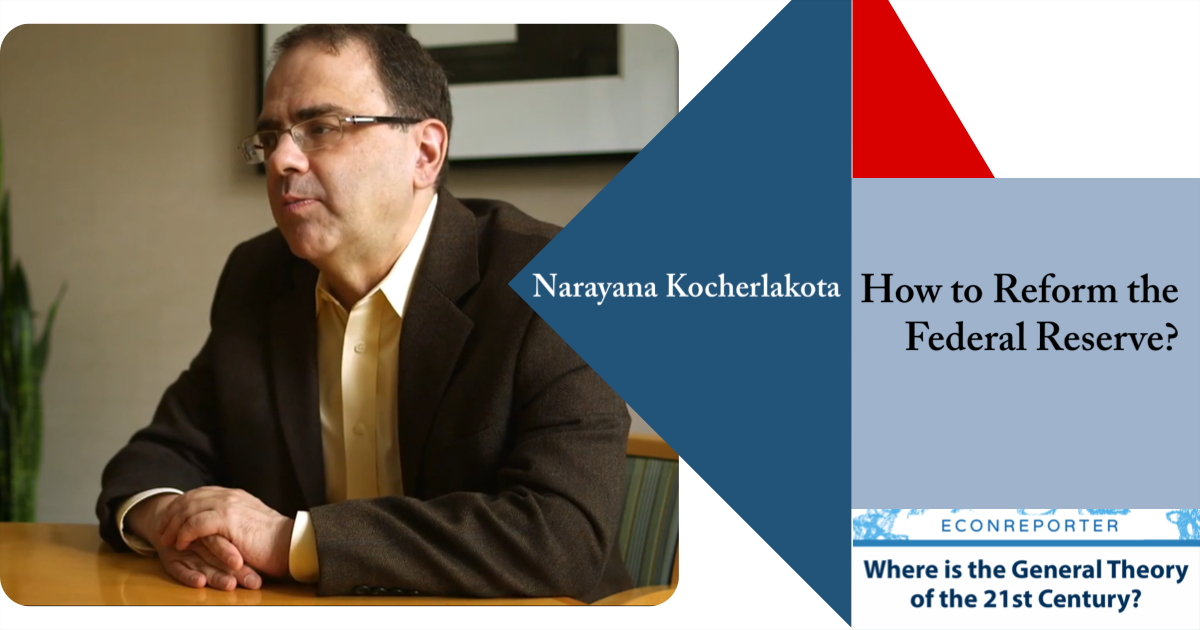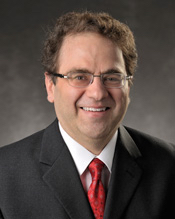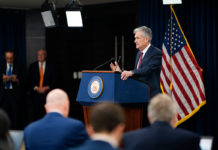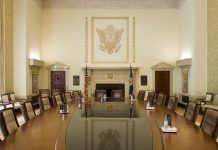Welcome to the latest installment of our interview series “Where is the General Theory of the 21st Century?”
“Where is the General Theory of the 21st Century?” is an interview series which we ask top economists a very important question: “Why haven’t economists come up with a new General Theory after the Great Recession?” We want to know how the macroeconomics academia has evolved since the Great Recession, and why the responses from macroeconomists since 2008 are different from their counterpart in the 1930s.
It is our great honor to have Narayana Kocherlakota as our latest guest. Prof. Kocherlakota is a professor of economics at the University of Rochester and was the President of the Federal Reserve Bank of Minneapolis from 2009 to 2015.
In Part I of our interview, Prof. Kocherlakota discusses his proposal for the reform of Federal Reserve System and how to improve the communications between the Fed and the public. In Part II, Kocherlakota will explain his view on post-2008 macroeconomics and the relationship between policy-making and academic research.
(The interview is edited for clarity. All mistakes are ours.)
Photo Credit: Brookings Institutions Youtube
Q: EconReporter K: Narayana Kocherlakota
Q: One of the things you often write about is that the Fed should improve its communication with the public. Why do you think communication is so important?
K: First, it’s important because of the nature of the nation we live in. We are living in a democracy. The Fed has been given a lot of latitudes to make decisions free of political pressures. That’s a good thing. I think this leads to better economic outcomes.
At the same time, the Fed owes it to the public to explain why it is doing what it is doing. If you don’t do that you will end up having mistrust in the Federal Reserve. I think we are seeing that right now in the US. We don’t have the level of trust I would like to see in the Fed and in other government entities.
On the Fed’s part, I think there has been a failure to communicate effectively about how it make the choices it does and why it makes the choices it does. We end up with a lot of misconceptions about the Federal Reserve as a result.
Related Readings:
Yellen Needs to Make More Speeches
What does the U.S. Federal Reserve think about the repercussions of Britain’s vote to leave the European Union? Amazingly, we still don’t really know — and we might not get a proper chance to find out until August or September. This dearth of information illustrates an important flaw in the way the world’s most powerful central bank communicates.
I can also give you a more academic answer. Which is simply that communications and common understandings of what the Fed’s objectives are can help the Fed achieve those objectives. If everyone understands the Fed is aiming for 2% inflation, that makes it a lot easier for the Fed to hit the 2% objective. If people’s expectations are not well-anchored then you start to see slippage, either upward or downward.
That’s a very technical answer. The reason which I am really passionate about is the first answer. It is the issue of trust in a democracy. What that means for technocratic and independent institutions like the Fed is that, as we make our decisions free of political pressure, we need to communicate effectively about why we are doing the things we are doing.
Q: Your successor in Minneapolis Fed, Neel Kashkari, just used Twitter and Medium to post this reason for dissenting the rate hike right before this interview. ([note]Editor’s note: this interview took place on March 17, the same date Neel Kashkari posted his Medium post.[/note]) Do you think this is an effective communication method? And would you like to see more communications like this?
Why I dissented https://t.co/Y0hpCqz4nI
— Neel Kashkari (@neelkashkari) March 17, 2017
K: It’s great. Without agreeing with everything Neel wrote, he actively articulated why he made the decision he made. I think it was great.
I think I maybe was the first person to do this kind of communications actually. I dissented in August 2011 and I put a YouTube video as soon as the blackout period ended, and tried to explain my reasoning for the dissent. That was very unusual and I think I was the first person to attempt to provide an immediate justification of my thinking.
@cloudyip pretty rough compared to @neelkashkari:https://t.co/WhKs7s0stz via @youtube
— NRKocherlakota (@kocherlakota009) March 17, 2017
Whether YouTube or Medium is the right platform, I will let others decide (Laughter). But I think it’s great. People understand now where Kashkari’s decision is coming from. People also got to hear from the Chair in the press conference talks about where the committee’s decisions were coming from. This is good. These allow people to understand what the Fed is thinking the way it is thinking.
Q: Why there are just the two of you doing this kind of communications? Why other Fed officials, especial those in the Washington, don’t do the same thing?
K: I do think that there were some other regional Fed presidents explained their dissents along the line. President Jeffrey Lacker of the Richmond Fed did it at least once. So, we are not alone on that.
In general, I think the non-New York regional Fed presidents do a good job in trying to communicate their ideas, on why they are thinking the way they are. For example, President Esther George of the of the Federal Reserve Bank of Kansas City, who I rarely agree with, is laying out exactly a very clear vision of a framework of monetary policy. The public knows why President George is dissenting when she dissents. That was all good.
For the Board of Governors, I don’t think that they communicate as effectively as I desire. There is a view that if people are aware of differences in perspective among the governors, somehow it will weaken the organization. But I just don’t think that is true. There was one governor that I think was extremely articulate and clear in his communications is Jeremy Stein. When he was the governor, I thought he did a great job.
Also, there is simply not enough dissent among the Governors. I think we only have two dissents from the governors in the last 20 years. There is too much agreement among in the Board of Governors. Given the complexity, the uncertainty and the challenges we have had in policymaking at the time, these extraordinarily talented and independently minded people are all agreeing with one and other. It doesn’t make sense to me. I think the public should expect more dissents from the governors, along with clear explanations on why they dissent. Otherwise, you sort of end up with this sort of black-room approach of policymaking.
In a section of his book “The Courage to Act”, Ben Bernanke wrote about how three governors, Powell, Stein, and Duke, were the main influences behind initiations of the tapering in 2013. All that took place behind the scenes. The public has no idea of that was going on. I just don’t think that is a good way to make policies. Fed Independence does not mean opaqueness. The only way for the independence to survive is for the Fed to be transparent about how it makes the decisions that it is making.

Q: In your recent paper, a review of Prof. Peter Conti-Brown’s book “The Power and Independence of the Federal Reserve”, you raised the question of whether the Fed should become a unified entity, instead of having 12 separate regional Feds. But as you have said, the regional Fed presidents are more open to disagree with the consensus. So, what is the benefit of unifying the Fed as one entity?
American Economic Association
The Decentralized Central Bank: A Review Essay on The Power and Independence of the Federal Reserve
K: I agree with what you just pointed out. Having the regional Fed presidents to be more open to disagree to the consensus is a huge benefit that we have. Separate presidents with separate staffs coming to the meetings. They are in the position to disrupt the groupthink we see in New York and Washington. I think that is very positive. Today is a great day to talk about this because I think President Kashkari is playing that role. That’s a good thing.
My article, though, pointed to the fact that the reasons for having these 12 separate regional Federal Reserve banks were that they were providing services to financial institutions. But that reason is vanishing very rapidly and much of it has been diminished over the last 20 to 30 years. Now, the separate corporate structure created a lot of inefficiencies in the running of the organization. It makes it much more challenging for the Fed to be as effective as it could be in the efficiency dimension. I think we have to weight these factors and figure out a way to somehow unify the corporate entities.
We need to make the decision about, for example, how do we tradeoff spending on check payments services being provided in the Atlanta versus spending on research in Minneapolis? How do we trade that off at the organizational level? Those are the tradeoff that the public would want us to make but we have no way to do that effectively because we have 12 separate corporate entities.
On the other hand, we don’t want to do anything that’s going to interfere with these very valuable independent prospectives that we get from the 11 non-New York regional Feds. That’s why I posed it as a question rather than an answer. I don’t know the answer but I think it’s a good question to be talking about because the changes have been so dramatic in term of what the regional banks do in term of the day to day basis. The purpose of the bank has changed so much and I think we really need some conversation about that.
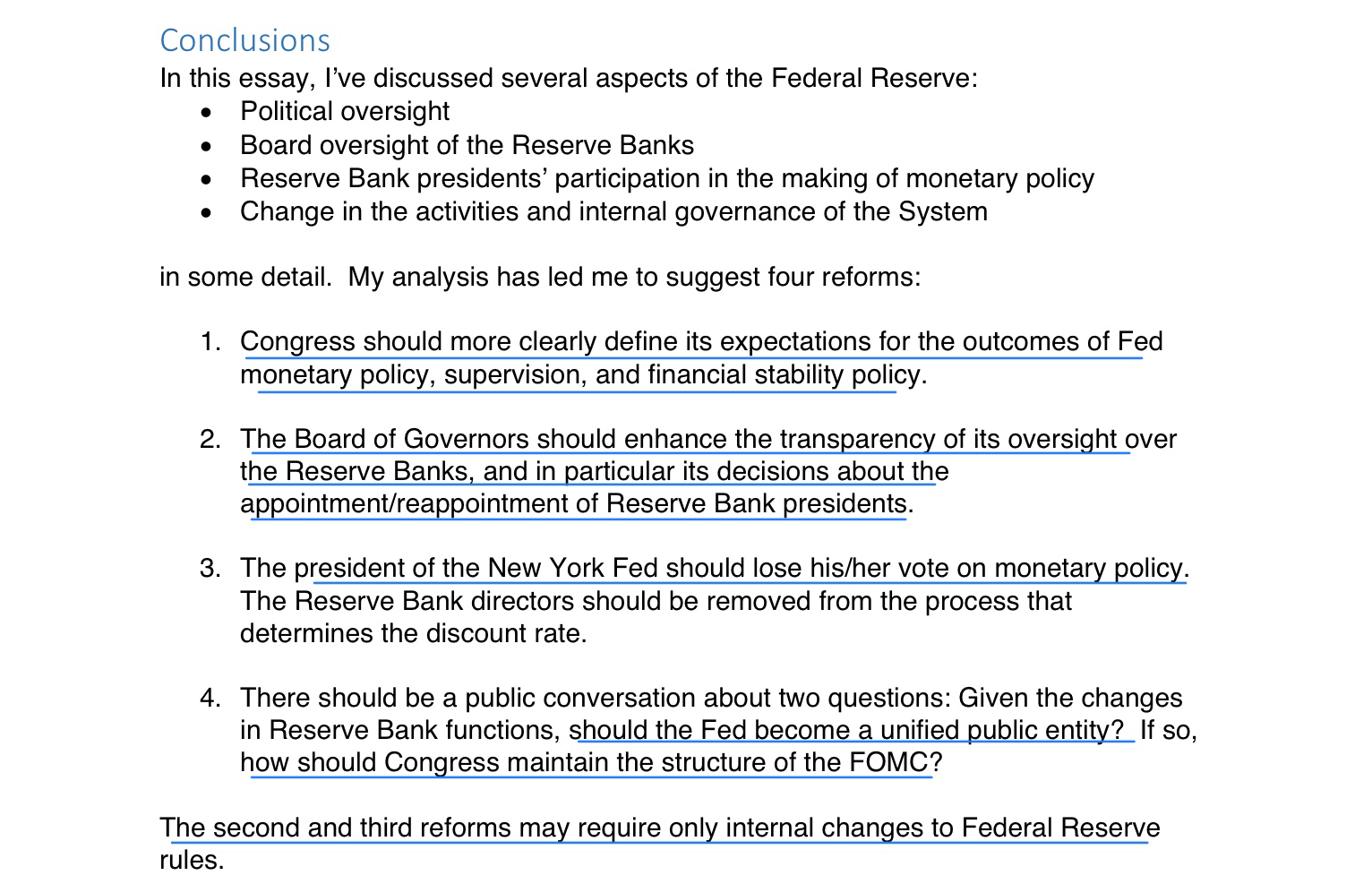
Q: In the same paper, you have also suggested that in the reform of the Fed structure, we should strip New York Fed of its vote of FOMC. Can you walk us through your reasoning?
K: That’s more about the effectiveness of the monetary policy. The role of the non-New York Presidents is very clear in the process. They are the disruptive force of the groupthink that you would otherwise get in the Washington-based entity. We have just talked about there were only two dissents in the last 20 years out of the Board of Governors. That’s groupthink in work. The non-New York Presidents played a very valuable role on that dimension. Plus, they are very important in communicating with their own districts. So, I think non-New York regional Feds provided the two-way communication role and the independent thinking. They are very essential.
The New York Fed doesn’t play these roles. The New York Fed’s functions are mainly about gathering information among the financial markets and performing the Fed’s market functions. These are all important things. But their stuff works very closely with the Washington staff. There is really no way that the New York President can be independent of the Washington groupthink.
Also, though there are certainly some two-way communications that the New York President does, there is only a limited amount of that. But most of what New York is doing is on the information gathering in Wall Street and implementation of Fed’s policy in Wall Street.
On the flip side, given the closeness of the New York Fed and the Wall Street, having the New York Fed President votes in the FOMC really creates some misperceptions about Fed’s monetary policy. So, I just don’t think you get much benefit from having the New York Fed President votes. They are very close to the Wall Street, and they are actually located right in the Wall Street. It looks like Wall Street has a lot of say over monetary policy. I just don’t think the pluses outweighs the negatives.

Q: In my opinion, both of yours and Prof. Conti-Brown’s suggestions on the Fed reform are excellent. It provided lots of ground for further discussion.Yet, it has been more than a year since the book published and your paper circulated, I still don’t find much of the discussion in this direction. Why don’t we have the discussions about the structure of the Fed and how to improve the efficiency of the Fed?
K: I think this is a great question. I am pretty surprised that there aren’t more conversations along this line. I think part of it is that the Fed is a complex organization. Even for people who spent a long time in the organization like myself, it is hard to know exactly how it works and what’s going on. So, to raise up these issues to the level of congress, it is very challenging. That’s one issue.
On the other hand, the Fed itself is very nervous about starting this kind of conversations. If you talk to individuals in the Fed and you get them speak off-the-record, probably you can get them to say “Yeah, there is room for improvement.” But they are very worried opening any conversation about improvement could lead the Congress to do far more than mere improvements.
To name a change that has been on the table, there are suggestions to make NY Fed President a position appointed by the President of the US and confirmed by the Senate. I think it would be a mistake. I rather have the New York Fed President keeps voting on the monetary policy than have that change made.
I get what the people in the Fed are thinking. They don’t want to be talking about possible changes because it could lead to things that they are really uncomfortable with.
The interview will be continued in Part II, where Kocherlakota will explain his view on post-2008 macroeconomics and the relationship between policy-making and academic research.
Why Kocherlakota is Disappointed with Post-Great Recession Macroeconomics | #WITGT21 Interview Series |
Welcome to the latest installment of our interview series “Where is the General Theory of the 21st Century?” “Where is the General Theory of the 21st Century?” is an interview series which we ask top economists a very important question: “Why haven’t economists come up with a new General Theory …


